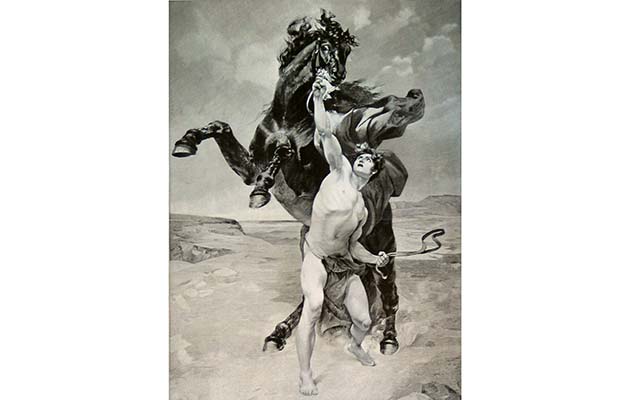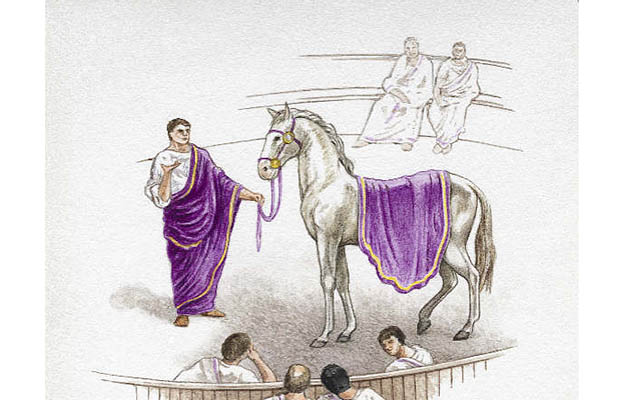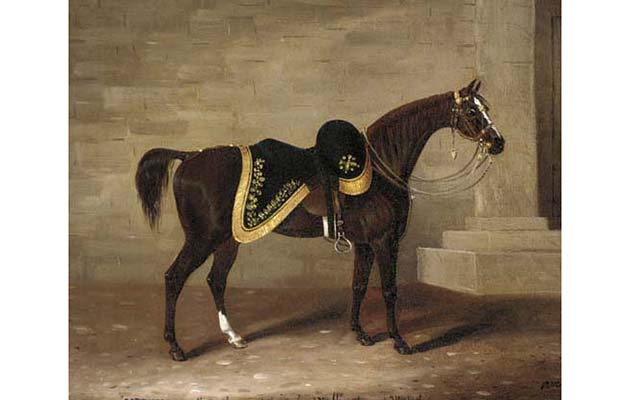From the winged horse Pegasus to the Duke of Wellington's trusty steed Copenhagen, take a look at these legendary horses from history
1. Pegasus
The winged horse Pegasus (pictured, above) is literally the stuff of legends. Ancient Greek legends, to be exact. A divine stallion, he’s said to have been fathered by the god Poseidon and foaled by the Gorgon Medusa, whose evil glare turned men to stone. He was then ridden by the hero Perseus, who chopped off the head of his mum Medusa and used it to kill the Kraken, but Pegasus doesn’t seem to have held a grudge about that. He had the useful talent of being able to create a spring just by striking the earth with his hoof, and went on to become the pet of the Goddess of Wisdom, Athena, before winding up as one of Zeus’s favourite horses, carrying the Father of the Gods’ thunderbolts for him. Zeus rewarded him for his years of loyal service by turning him into a constellation, and he can be spotted hanging out up there with the stars on any clear night.
2. Bucephalus
Alexander the Great was the king of Macedonia who, in around 340BC, conquered pretty much the entire known world, but whose burning, deadly ambition we can overlook because he was clearly a man who loved his horses. And his favourite horse of all was Bucephalus, a hulking black horse with a large white star and a wall eye. As a young boy, Alexander was given the wild colt by a horse dealer, and is said to have tamed him himself. Bucephalus went on to serve Alexander as his charger in countless battles, all of which the legendary pair won. History isn’t quite so clear as to how long he lived. He is variously said to have died in the Battle of the Hydaspes (which Alexander won, natch) — and to have outlived his master, dying at the ripe old age of 30. We like that version best.
3. Incitatus
Caligula, Roman emperor from 37-41AD, admired Alexander the Great enormously, and wished to emulate him. Unfortunately, he was mad as a box of frogs and a useless general. Best known for his cruelty, tyranny and incest with his sisters, when not busy doing dreadful things, he spent a lot of time with his horse, Incitatus, fondly imagining the pair of them to be just like Alexander and Bucephalus. Incitatus had a marble stable, ivory manger, and a collar of precious stones, and was fed oats mixed with flakes of gold. It’s said that Caligula planned to make him a Senator — one of the elevated public servants that ruled Rome — but the fed-up Senate decided to have Caligula assassinated instead. So that was that.
Continued below…
From loose horses, Johnny Depp's saddle slipping and a serious booting, films and TV shows have provided us with som

6 horsey film and TV bloopers *VIDEO*
4. Marengo
A grey Arabian standing at just 14.1hh, Marengo was the steed of none other than Napoleon (famously no giant himself). Imported to France from Egypt as a six-year old, Napoleon rode Marengo during the battles of Austerlitz, Jena-Austetd and Wagram, which he won, and the Battle of Waterloo, which he didn’t. The stallion was captured during the Battle of Waterloo and brought to Britain, where he was kept at stud until eventually dying of old age at 38. His skeleton was preserved and is now on display at the National Army Museum in Chelsea, London.
5. Copenhagen
The trusty steed of the Duke of Wellington, Copenhagen was on the winning side in the Battle of Waterloo, riding against Napoleon and Marengo. It would be poetic to imagine the fiery clash of the two famous war horses, but it probably didn’t happen. The original ROR, of mixed thoroughbred and Arabian heritage, Copenhagen won two out of 12 races, before being sold to the Duke of Wellington and becoming his favourite. He lived out his life at the Duke’s Stratfield Saye House estate, dying in 1836, aged 28. His resting site is marked with a marble headstone, under a huge Turkey Oak, and he was buried with full military honours. Wellington said of the dark chestnut, said to be hollow-backed and with bad shoulders, “There may have been many faster horses, no doubt many handsomer, but for bottom and endurance I never saw his fellow.” Copenhagen reportedly liked to eat lying down, and had a fondness for cake.









